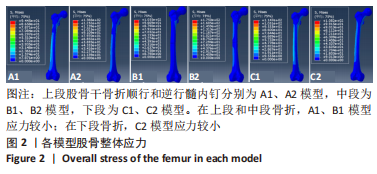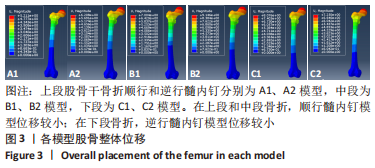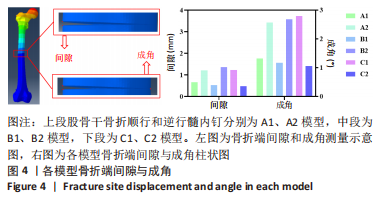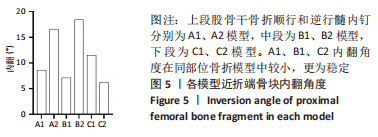[1] 何嘉承. 两种不同手术方法对股骨干骨折患者的影响[J]. 中国医学创新,2022,19(31):54-58.
[2] 魏文强, 顾峥嵘, 崔进,等. 股骨转子间冠状位骨折的形态学分析及其对复位内固定技术的影响[J]. 中国修复重建外科杂志,2021, 35(9):1093-1099.
[3] 邓智斌. 开放复位与闭合复位交锁髓内钉内固定治疗股骨干骨折的疗效对比[J]. 医学食疗与健康,2022,20(23):56-58+62.
[4] MOHAMED MA, NOAMAN HH, SOROOR YO, et al. Plate augmentation and bone grafting in treatment of femoral shaft nonunion initially fixed by intramedullary nail. SICOT J. 2022;8:19.
[5] ALT V. Treatment of an infected nonunion with additional fresh fracture of the femur with a silver-coated intramedullary nail: A case report. Trauma Case Rep. 2022;39:100641.
[6] 张刚, 刘亚, 冯源,等. 桥接系统去皮质术治疗股骨干骨折不连接[J]. 中国矫形外科杂志,2021,29(16):1523-1526.
[7] 孙贺, 孙亮, 李忠,等. 股骨干骨折术后骨不连的诊疗进展[J]. 骨科, 2020,11(4):344-347.
[8] 张伟, 陈华, 唐佩福. 股骨干无菌性骨不连的最新治疗进展[J]. 中国修复重建外科杂志,2018,32(5):519-525.
[9] 宋启威. 逆行和顺行交锁髓内钉治疗股骨干骨折对比观察[D]. 合肥:安徽医科大学,2017.
[10] Abdillahi IB. 顺行髓内钉与逆行髓内钉治疗股骨中段骨折疗效的回顾性对比研究[D].长春:吉林大学,2019.
[11] 袁家钦, 栾富钧, 陈杨帆,等. 顺行与逆行髓内钉治疗股骨远段关节外骨折疗效的Meta分析[J]. 中国组织工程研究,2021,25(30): 4915-4920.
[12] 陈心敏, 江腾, 杨威,等. 不同长度股骨近端防旋髓内钉治疗老年A3.3型股骨转子间骨折的有限元分析[J]. 中国医药导报,2020, 17(27):92-95+197.
[13] 黄培镇, 陈心敏, 郑利钦,等. 骨水泥增强股骨近端防旋髓内钉治疗高龄不稳定型股骨转子间骨折的有限元分析[J]. 天津医药,2020, 48(5):385-390+466.
[14] 蔡群斌, 姜自伟, 林梓凌,等. 股骨近端防旋髓内钉不同进钉点治疗外侧壁破裂型股骨转子间骨折的有限元分析[J]. 天津医药,2020, 48(2):105-109+163-164.
[15] 陈心敏, 李文标, 熊凯凯,等. 钉道强化股骨近端防旋髓内钉治疗老年A3.3型股骨转子间骨折:最佳骨水泥量有限元分析[J]. 中国组织工程研究,2021,25(9):1404-1409.
[16] 陆定松, 李永刚, 杨志奎,等. 切开复位交锁髓内钉内固定与闭合复位交锁髓内钉内固定治疗老年股骨干骨折的效果比较[J]. 临床医学研究与实践,2022,7(1):82-85.
[17] 张伟, 李建涛, 聂少波,等. 多维交叉锁定接骨板治疗股骨干髓内钉术后骨不连的临床疗效研究[J]. 中华骨与关节外科杂志,2021, 14(4):292-297.
[18] RICHARD E, BUCKLEY CGM, APIVATTHAKAKUL T. 骨折治疗的AO原则[M]. 3版. 上海:上海科学技术出版社,2020:760-762.
[19] 仲飙, 孙辉, 潘垚,等. 逆行和顺行交锁髓内钉治疗股骨干骨折的比较研究[J]. 实用骨科杂志,2008,14(4):201-204.
[20] 宋启威, 朱亚朋, 汤健. 逆行和顺行交锁髓内钉治疗股骨干骨折对比观察[J]. 医学信息,2017,30(8):31-33.
[21] 李思颖, 滕加文, 吴伟山. 逆行和顺行置髓内钉治疗股骨干骨折的疗效比较[J]. 临床骨科杂志,2021,24(2):265-269.
[22] 陈立翔, 娄博, 王焕. 基于有限元法的数字化建模在拇外翻研究中的应用[J]. 医用生物力学,2022,37(5):972-977.
[23] 国婷婷, 谢红. 有限元法在足踝生物力学研究中的应用进展[J]. 医用生物力学,2022,37(4):766-770.
[24] 金琰琰, 叶豪, 李妍妍,等. 尺骨冠状突骨折合并肘关节后脱位有限元模型的建立与分析[J]. 温州医科大学学报,2022,52(7):539-544.
[25] 梁梓扬. 基于主动肌肉动力稳定的头-颈椎非线性有限元模型构建及其应用研究[D]. 广州:广州中医药大学,2021.
[26] 常文举, 丁海. 股骨近端解剖与生物力学研究进展[J]. 医用生物力学,2016,31(2):188-192.
[27] KONSTANTINIDIS L, PAPAIOANNOU C, BLANKE P, et al. Failure after osteosynthesis of trochanteric fractures. Where is the limit of osteoporosis? Osteoporos Int. 2013;24(10):2701-2706.
[28] 李伟, 谭杜勋. 逆行髓内钉固定联合钛缆环扎治疗股骨远端骨折[J]. 国际骨科学杂志,2022,43(2):115-119.
[29] 杨康华, 杨晶, 杨广忠. 三种内固定物治疗股骨远端骨折的稳定性比较[J]. 中国组织工程研究,2014,18(4):565-570.
[30] 吕宇明, 蒋云楼, 罗国富. 顺行和逆行交锁髓内钉对股骨中下段骨折的疗效观察[J]. 当代医学,2019,25(20):50-51.
[31] 毛文文, 陈昊, 李立,等. 逆行和顺行髓内钉治疗股骨干中段骨折的研究[J]. 实用临床医药杂志,2022,26(17):87-91.
[32] 杨楷文, 何思远, 罗亮,等. 侧方钢板联合植骨治疗股骨干骨折髓内钉固定术后不愈合17例[J]. 中国中医骨伤科杂志,2022,30(7): 65-69.
[33] 解凯宇, 滕加文. 髓内钉加钢板钢缆联合植骨治疗股骨干骨折术后骨不连[J]. 临床骨科杂志,2022,25(3):351.
[34] 郑利钦, 陈心敏, 张彪,等. 股骨转子间骨折股骨近端防旋髓内钉内固定切割失效的有限元仿真[J]. 中国组织工程研究,2019,23(36): 5794-5799.
[35] 王飚, 黄常红, 王延嗣,等. 阻挡螺钉配合逆行髓内钉内固定治疗股骨远端骨折的临床研究[J]. 中国现代医生,2019,57(10):79-82.
[36] 张端, 宋钢兵, 郑国瑜,等. 阻挡钉在交锁髓内钉治疗股骨远端干骺端骨折患者中的应用分析[J]. 健康必读,2022(9):143-144.
[37] 黄佳平, 陈志达, 丁真奇,等. 交锁髓内钉联合与不联合阻挡螺钉内固定治疗老年股骨干骨折的疗效比较[J]. 中国骨与关节损伤杂志,2022,37(2):186-188. |







